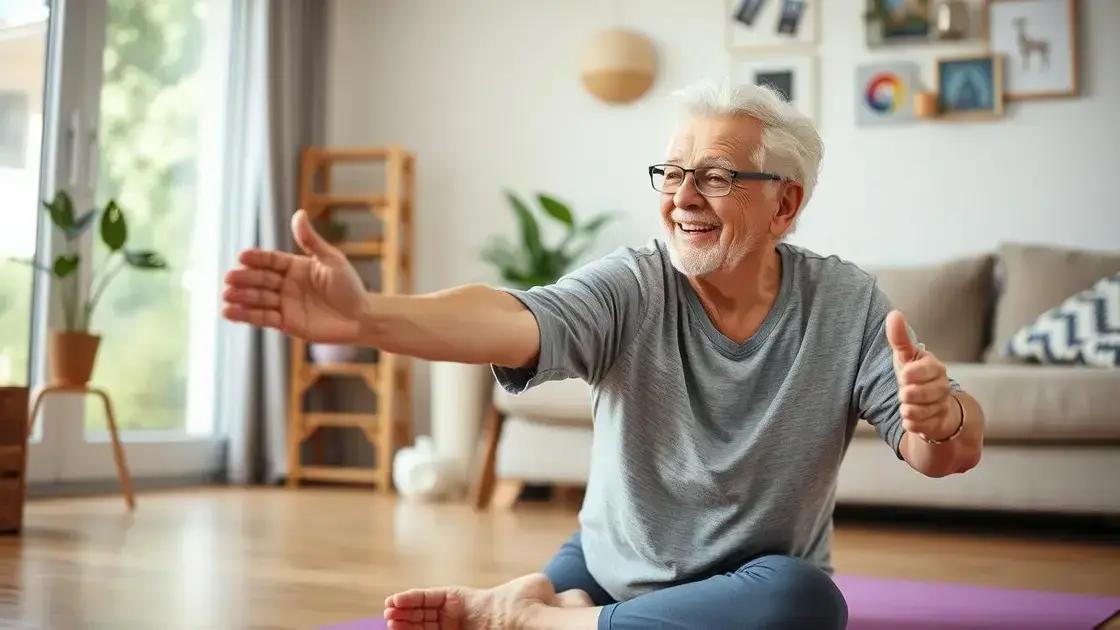Transitioning from a sedentary lifestyle to an active one in your 50s is achievable by understanding the risks of inactivity, gradually starting to exercise, incorporating physical activity into your daily routine, and staying motivated through clear goals, tracking progress, and social support.
Are you in your 50s and looking to transition from a sedentary to an active lifestyle? This transition is crucial for enhancing your health and longevity. By embracing a more active way of living, you can improve your physical fitness, mental well-being, and overall quality of life. In this article, we will discuss understanding the risks of a sedentary lifestyle, simple steps to begin exercising, incorporating physical activity into daily routines, and staying motivated during your fitness journey.
Understanding Sedentary Lifestyle Risks

Understanding the risks of a sedentary lifestyle is crucial, especially for those in their 50s. A sedentary lifestyle can lead to many health issues, including obesity, heart disease, and diabetes. When you’re not active, your heart and muscles don’t get the workout they need. This can ultimately lead to decreased strength and endurance.
Physical Health Risks
One of the major concerns is the risk of obesity. When you consume more calories than you burn through physical activity, your body stores excess energy as fat. This can lead to weight gain and increase the likelihood of serious conditions like hypertension and high cholesterol.
Mental Health Impact
A sedentary lifestyle can also affect your mental health. Studies show that physical inactivity can increase feelings of anxiety and depression. Regular exercise is known to boost mood and improve overall mental well-being. Being active helps release endorphins, which are chemicals in the brain that act as natural painkillers and mood elevators.
Increased Risk of Injury
When you don’t exercise regularly, your muscles and joints become stiff and weak. This lack of strength and flexibility increases the risk of injuries. Activities that require sudden movements can lead to strains or falls. Keeping your body engaged through regular exercise can help maintain muscle strength and flexibility and reduce injury risks.
Social and Emotional Effects
A sedentary lifestyle can also lead to social isolation. When people refrain from being active, they often miss out on social interactions that come from group activities or sports. Social connections are crucial for emotional health, and staying active can provide opportunities to meet new people and maintain relationships.
Recognizing these risks highlights the importance of transitioning to a more active lifestyle. By making small, gradual changes, you can significantly improve your overall health and quality of life.
Simple Steps to Begin Exercising

Beginning an exercise routine can be challenging, but with simple steps, it becomes more manageable. Here are some practical tips to help you get started.
Start Slow
If you haven’t exercised in a while, it’s important to begin gradually. Start with short sessions of 10 to 15 minutes of physical activity. As you grow more comfortable, you can gradually increase the duration to 30 minutes or more.
Choose Activities You Enjoy
Select activities that you find enjoyable. Whether walking, swimming, or dancing, engaging in fun exercises makes it easier to stick to your routine. You may also consider joining a local class or group to make it more social.
Set Realistic Goals
When starting, set achievable goals. Rather than aiming for intense workouts, focus on consistency. For example, aim to exercise three times a week. As you progress, adjust your goals to challenge yourself further.
Create a Schedule
Make a schedule that works for you. Block out specific times in your week dedicated to exercise. Treat these appointments just like any other commitment to ensure they’re part of your routine.
Warm Up and Cool Down
Always include warm-up and cool-down periods in your exercise sessions. This helps prepare your body for activity and aids recovery afterward. Spend five minutes doing light stretching or walking before and after your workouts.
Listen to Your Body
Pay attention to how your body feels during exercise. If you experience pain or discomfort, stop immediately and rest. It’s important to differentiate between the normal muscle soreness of exercise and actual pain that could be a sign of injury.
Stay Hydrated
Hydration is vital. Drink water before, during, and after physical activities. Proper hydration helps maintain your body function efficiently and supports your overall health.
These simple steps can guide you on your journey to become more active. By making small adjustments and focusing on activities you enjoy, you’ll find it easier to integrate exercise into your life.
Incorporating Physical Activity into Daily Life

Incorporating physical activity into your daily life can be easier than you think. Here are some practical ways to stay active throughout the day.
Walk More
Consider walking whenever possible. Whether it’s parking further from the entrance at work, using stairs instead of elevators, or taking a short walk during breaks, every step counts. Aim for at least 30 minutes of walking daily, spread out in smaller sessions if needed.
Make Household Chores Active
Transform your household chores into mini workouts. Activities like vacuuming, gardening, and washing the car can help you burn calories while keeping your home tidy. Put on some music and enjoy these tasks as enjoyable physical activities.
Exercise While Watching TV
While watching your favorite shows, incorporate exercises like stretching, yoga, or using light weights. Stand up and do leg lifts or marching in place during commercials. This way, you can relax and stay active at the same time.
Engage in Social Activities
Choose social activities that involve movement. Join a walking group, dance classes, or community sports teams. Doing physical activities with others not only keeps you active but also helps build friendships and enhance social connections.
Set Reminders
Use technology to your advantage. Set reminders on your phone or computer to encourage breaks for movement. Every hour, take a few minutes to stretch or walk around. These small breaks can improve circulation and reduce fatigue.
Incorporate Physical Activity in Family Time
Turn family time into active time. Plan outings that involve physical activities, like hiking, biking, or dancing. This is a great way to bond with your loved ones while promoting an active lifestyle.
By consistently infusing physical activity into your daily routine, you can create lasting habits that promote a healthier and more active life.
Staying Motivated in Your Fitness Journey

Staying motivated in your fitness journey is key to long-term success. Here are some effective strategies to help you maintain your enthusiasm.
Set Clear Goals
Establish specific, measurable, achievable, relevant, and time-bound (SMART) goals for your fitness journey. Instead of saying, “I want to be fit,” you might set a goal like, “I will walk 30 minutes every day for the next month.” Clear goals help track progress and provide motivation.
Track Your Progress
Keep a fitness journal or use mobile apps to track your workouts and progress. Recording your achievements can boost your motivation. Celebrate milestones, no matter how small, to encourage yourself to keep going.
Find a Workout Buddy
Exercising with a companion can make workouts more enjoyable. A workout buddy offers social support, accountability, and encouragement. You can share your goals and celebrate successes together.
Try New Activities
To keep things exciting, do not be afraid to explore different types of exercises. If you usually walk, try swimming or joining a dance class. Variety prevents boredom and challenges your body in new ways.
Reward Yourself
Give yourself rewards for achieving your fitness goals. It could be something small, like a new workout outfit or a relaxing massage. These incentives can boost your motivation to reach your next goal.
Stay Positive
Maintaining a positive mindset is crucial. Focus on how great you feel after a workout rather than how hard it is to exercise. Surround yourself with supportive people who encourage your efforts and celebrate your successes.
Remind Yourself of the Benefits
Keep in mind the numerous benefits of being active, such as increased energy, improved mood, and better overall health. Whenever your motivation dips, remind yourself why you started this journey.
By incorporating these strategies, you can stay motivated and make your fitness journey enjoyable and sustainable.
Embrace an Active Lifestyle in Your 50s
Transitioning from a sedentary to an active lifestyle in your 50s is not only possible but also rewarding. By understanding the risks of inactivity, following simple steps to start exercising, and finding ways to incorporate physical activity into your daily life, you can greatly improve your health and well-being.
Staying motivated is essential, and with clear goals, tracking your progress, and a supportive community, you can enjoy this journey. Remember, every movement counts, and it’s never too late to start. Embrace this opportunity to enhance your quality of life and enjoy the benefits of an active lifestyle.
So take that first step today, and discover the positive changes that come with being active!
FAQ – Frequently Asked Questions About Transitioning to an Active Lifestyle in Your 50s
What are the risks of a sedentary lifestyle?
A sedentary lifestyle can lead to various health issues such as obesity, heart disease, and mental health challenges like anxiety and depression.
How can I start exercising if I’ve been inactive?
Start slow by engaging in short sessions of 10 to 15 minutes of activity, choosing enjoyable exercises, and gradually increasing the duration as you feel more comfortable.
What are some easy ways to incorporate physical activity into my daily routine?
You can walk more, make household chores active, stretch while watching TV, engage in social activities, and set reminders to take movement breaks.
How do I stay motivated to continue my fitness journey?
Set clear goals, track your progress, find a workout buddy, try new activities, reward yourself, maintain a positive mindset, and remind yourself of the benefits of being active.
What should I do if I feel pain while exercising?
If you experience pain, stop exercising immediately and rest. It’s important to distinguish between normal muscle soreness and pain that could indicate an injury.
How can I make exercise more enjoyable?
Choose activities you enjoy, mix up your routine with different exercises, involve friends or family for social engagement, and listen to music or podcasts while working out.












